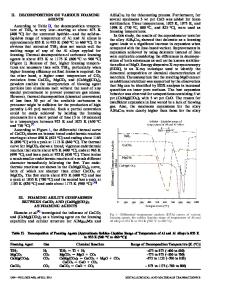Polymer Nanocomposite Foams Prepared by Supercritical Fluid Foaming Technology
- PDF / 1,441,934 Bytes
- 6 Pages / 612 x 792 pts (letter) Page_size
- 94 Downloads / 382 Views
Polymer Nanocomposite Foams Prepared by Supercritical Fluid Foaming Technology L. James Lee, Changchun Zeng, Xiangmin Han, David L. Tomasko, Kurt W. Koelling, Department of Chemical Engineering, The Ohio State University Columbus, OH 43210 ABSTRACT Polystyrene (PS) clay nanocomposites were synthesized and used to prepare foams in both batch and continuous extrusion process. It was found that the addition of a small amount of clay could greatly reduce cell size and increase cell density. Once exfoliated, the nanocomposite foam exhibits the highest cell density and the smallest cell size at the same particle concentration. Exfoliated microcellular nanocomposite foams with good surface quality was successfully produced using supercritical carbon dioxide. INTRODUCTION Polymer based foams are widely used in many applications, from packaging materials, insulation panels, cushions, to scaffolds for tissue engineering. Recently developed microcellular foams have drawn a great deal of attention and interest. These microcelluar foams have pore size less than 10 microns and foam density about 0.5 to 0.8. They have superior properties [1]. To obtain cells with controlled structure and uniform distribution, a common practice is to add particles (nucleation agents) as ‘hot spots’ and to reduce the nucleation energy. Among them, the inorganic nucleation agents are the most commonly used [1]. A fine dispersion of these nucleation agents can assist the formation of nucleation centers for a gaseous phase. Although the nucleation mechanism is still under investigation, it is generally known that the size, shape, and distribution of the particles, as well as the surface treatment can affect the nucleation efficiency [2]. A common practice to increase talc nucleation efficiency is to coat surfactants on talc surface. Yang et al [3] studied the effects of the type and concentration of nine nucleation agents coated with Zn stearate or Al stearate on the foam extrusion of low-density polyethylene. The experimental results are in good agreement with theoretical prediction. Park et al [4] studied the effect of talc on the cell nucleation of polypropylene foamed by CO2 and isopentane. When isopentane is used as a foaming agent, nucleation is dominated by the talc concentration and not affected too much by isopentane concentration. By contrast, CO2 content decides the cell nucleation and the presence of talc is significant only at low CO2 content. It was shown that the presence of filler promoted the accumulation of gas on the polymer-particle interface and creation of nucleation sites [5]. Furthermore, Foams with finer fillers show a higher cell density at a high saturation pressure and a lower cell density at a low saturation pressure. Generally, the particles used in these studies are of micron size. Recently the use of layered silicates (clay minerals) nanoparticles to reinforce polymers has drawn a great deal of attention. Adding a small amount of nanoparticles can dramatically improve a wide variety of properties of polymer matrix [6]. C
Data Loading...











